Pesticide usage - rodenticides on arable farms 2018: survey results
Information from a survey of rodenticide use on arable farms in Scotland in 2018.
This document is part of a collection
Rodenticide use data
Rodenticide use data were collected from 272 arable holdings in Scotland in 2018. The farms surveyed represented three per cent of the total arable holdings in Scotland. These holdings collectively grew seven per cent of the 2018 arable crop area. The data collected from this sample were used to estimate rodenticide use on all Scottish arable farms in 2018.
Percentage of farms using rodenticides and type of user
It was estimated that approximately 55 per cent of Scottish arable farms used rodenticides in 2018 (Figure 1). Over half of all baiting operations (54 per cent) were implemented by Pest Control Professionals (PCPs). Farmers conducted baiting on the remainder of these farms.
Similar proportions were recorded in relation to the amounts of rodenticides used with PCPs responsible for 56 per cent of the total use by weight of product.
Figure 1 Percentage of arable farms using rodenticides and type of user 2018
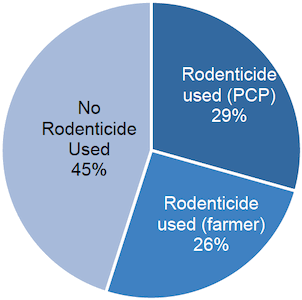
The pattern of rodenticide use, and primary user, encountered in this survey was significantly different (P<0.001) to that reported in 2016 (Figure 2). The proportion of arable farms using rodenticides (55 per cent) was lower than in 2014 (71 per cent) and significantly lower (P<0.001) than in 2016 (78 per cent).
In 2018, on farms where rodenticides were used, the proportion applied by PCPs (54 per cent) was greater than in 2014 (46 per cent) and significantly greater than in 2016 (40 per cent, P=0.004).
Both the decreased use of rodenticides and the increased use in PCPs encountered in 2018 may be influenced by the UK rodenticide Stewardship Scheme. The scheme, which is aimed to improve the uptake of best practice in relation to rodenticide use, was introduced in 2015. As a consequence, farmers are required to provide proof of competence or membership of a stewardship-approved quality assurance scheme to purchase their rodenticides or alternatively employ the services of a qualified professional.
Figure 2 Percentage of arable farms using rodenticides and type of user 2014 to 2018
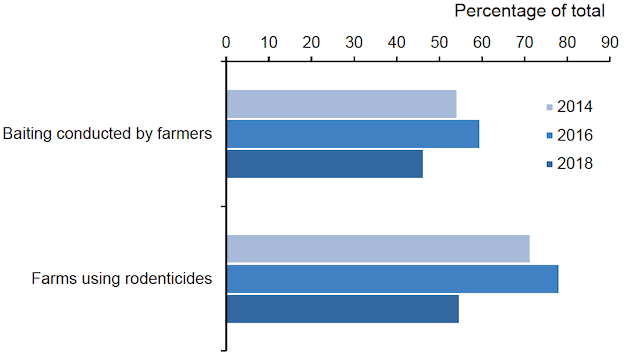
Note: There are statistically significant decreases in the number of farms using rodenticides (P<0.001) and the proportion of baiting conducted by farmers (P=0.004) between 2016 and 2018
Rodenticides encountered and their estimated occurrence
During this survey, product information was recorded for 87 per cent of all occurrences of rodenticide use. For the remaining 13 per cent, whilst it was recorded that rodenticides had been applied, the product used was not specified. This was either a result of farmers not having adequate records of the exact product used or PCPs not responding to requests for product information. The level of unspecified rodenticides in 2018 was three times that encountered in the previous survey (four per cent). The following sections only discuss the use of specified rodenticides.
Rodenticide occurrence is defined as the number of holdings on which a formulation (the combination of active substances formulated together in a product) is encountered. Multiple uses of the same formulation at the same holding are counted as a single occurrence (refer to Appendix 3 for further explanation of these definitions).
Seven active substances were recorded on arable farms in 2018; alphachloralose, brodifacoum, bromadiolone, coumatetralyl, difenacoum, difethialone and warfarin (Table 1, Figure 3). Alphachloralose has a narcotic mode of action, depressing the central nervous system. All the other rodenticides encountered were anticoagulants, which prevent the synthesis of blood clotting factors and cause rodent death by haemorrhage. Two of the active substances were first generation anticoagulant rodenticides (FGARs; coumatetralyl and warfarin). The other four active substances were second generation anticoagulant rodenticides (SGARs) and these SGARs collectively accounted for more than 98 per cent of all occurrences of specified rodenticide use in 2018. Over the last three surveys rodenticide use has been almost exclusively composed of SGARs (100, >99 and > 98 per cent in 2014, 2016 and 2018 respectively, no significant difference between years).
The most commonly encountered active substances were bromadiolone and difenacoum (57 and 33 per cent of occurrences respectively). Other active substances recorded were brodifacoum (six per cent of occurrences), difethialone (two per cent), alphachloralose (one per cent) and coumatetralyl and warfarin (both less than one per cent).
The dominance of bromadiolone and difenacoum occurrence reflects their being the most commonly available rodenticides. At the time of writing, bromadiolone and difenacoum containing products account for 67 per cent of all anticoagulant rodenticide approvals, 69 per cent of outdoor use around buildings and 98 per cent of those approved for use in open areas(3).
Figure 3 Percentage occurrence of rodenticide active substances on arable farms – 2018
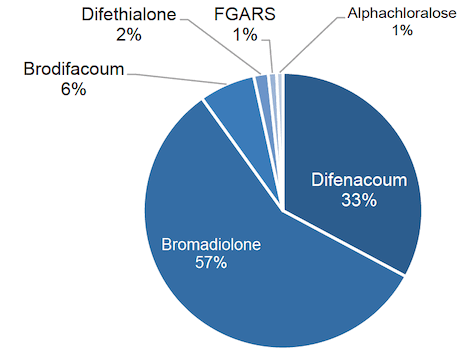
Note: FGARs are coumatetralyl and warfarin.
The combined use of bromadiolone and difenacoum has changed little over time, accounting for 97, 92 and 90 per cent of rodenticide occurrences in 2014, 2016 and 2018 respectively. However, the relative proportions of these two compounds have changed since the last survey. In 2018, the number of farms using bromadiolone was significantly greater (p-value 0.004) than in 2016. In contrast, significantly fewer farms used difenacoum in 2018 (p-value <0.001) than in 2016. However, the proportions of occurrences encountered in 2018 are very similar to those encountered in 2014 (Figure 4). The relative proportions of these compounds vary in the longer-term dataset (1992 onwards) and it is not clear what the drivers for these variations are. It is possible that this may be a response to product efficacy in some areas; resistance to both difenacoum and bromadiolone has been reported in Scotland(4). It may also represent a response to differences in the range of approved products available, and their marketing strategies over time.
The use of brodifacoum, the third most commonly encountered rodenticide in this survey is very similar to that recorded in 2016 (six per cent). Prior to 2018, the use of brodifacoum increased from three per cent in 2014 to six per cent in 2016.
Figure 4 Percentage occurrence of rodenticides on arable farms 2014 to 2018
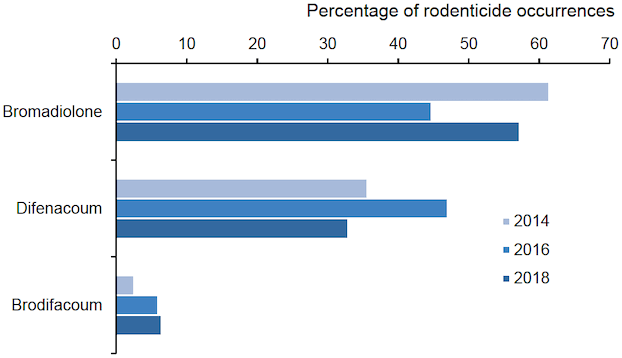
Note: There are statistically more farms used bromadiolone in 2018 (p-value 0.004) than in 2016. In contrast, fewer farms used difenacoum (p-value <0.001). There was no significant difference for the proportion of farms using brodifacoum between 2016 and 2018.
Weight of rodenticides used
Approximately 49 tonnes of rodenticidal products are estimated to have be used on Scottish arable farms in 2018 (Table 2, Figure 5). More than 99 per cent of the total weight used was SGAR products. Products containing bromadiolone were the most commonly used (ca.35 tonnes), accounting for 72 per cent of total rodenticide use by weight. Difenacoum products were the second most commonly used (ca. 11 tonnes) accounting for 23 per cent of total use. Brodifacoum was the only other rodenticide regularly encountered (ca. one tonne), accounting for three per cent of total use. Individual formulation weights, the weight of active substances present in the product not including baits, are also presented in Table 2. Anticoagulant rodenticide products contain very small amounts of active substance. The ca. 49 tonnes of rodenticide product used on arable farms in 2018 contained only ca. 5.8 kg of active substance, the remainder of the product weight is almost exclusively food bait used to attract rodents.
Figure 5 Percentage weight of rodenticide product used on arable farms 2018
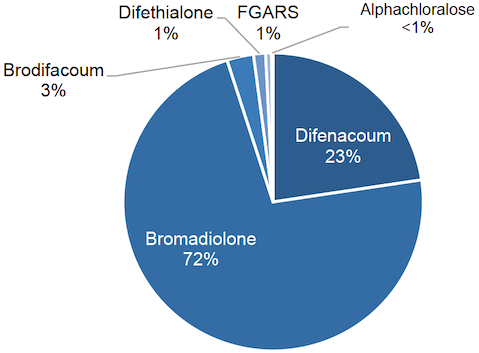
Note: FGARs are coumatetralyl and warfarin.
The estimated weights of the three main rodenticides recorded in the 2014, 2016 and 2018 arable crop surveys are presented in Figure 6. There has been a large decrease in overall weight of rodenticide products applied between these surveys. Rodenticide use in 2018 (ca. 49 tonnes) was 47 per cent lower than in 2016 (ca. 91 tonnes) and 57 per cent lower than in 2014 (ca. 113 tonnes). This may have been influenced by the increase in unspecified rodenticides recorded in 2018. Rodenticides are recorded as unspecified when use has been recorded but product information is not available, therefore these rodenticides are excluded from weight calculations. However, this decline in overall rodenticide use on arable farms is similar to that recorded in recent grassland and fodder farms surveys. The weight of rodenticide products used on Scottish grassland and fodder farms in 2017 was 40 per cent lower than in 2013(5). The decline recorded in this survey appears to be a continuation of a longer term-trend of decreasing use in arable agriculture. The estimated use in 2018 is 66 per cent lower than that reported in 2000 (ca. 144 tonnes)(6). This has partly been driven by a decline in the proportion of farms on which baiting is conducted (76 and 55 per cent in 2000 and 2018 respectively).
At active substance level, large decreases in the weight used were recorded for both difenacoum and brodifacoum use (73 and 70 per cent from 2016 to 2018 respectively). Applications of products containing bromadiolone also decreased, but the decrease (21 per cent) was less marked (Figure 6). The reasons for these declines are unclear, and it should be noted that rodent populations, and thus rodenticide use, fluctuate over time. However, these declines, which have been detected in both arable and grass and fodder crop systems, are also likely to have been influenced by the Campaign for Responsible Rodenticide Usage (CRRU) guidance for best practice(7) and the 2015 launch of the UK industry led rodenticide stewardship scheme(8).
Figure 6 Weight of rodenticide product used on arable farms 2014 to 2018
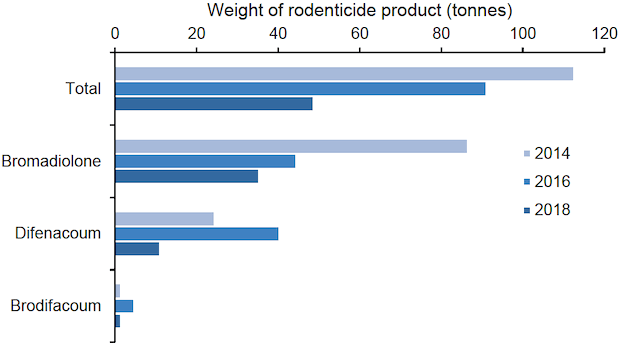
Seasonal use of rodenticides
The season in which rodenticides were used was specified for all the rodenticides encountered in this survey. Sixty-one per cent of use was reported to occur throughout the year. This included farms practising permanent baiting and those conducting multiple separate baiting operations. This is an increase from the level of year-round baiting encountered in 2016, in which 46 per cent of rodenticides were reported to be used throughout the year. However, similar levels of year round baiting for anticoagulant rodenticides have been reported previously, with 65 and 51 per cent in 2012 and 2014 respectively.
When the weight used, including year-round use, is separated into constituent seasons, the greatest use was in winter (38 per cent) and autumn (27 per cent), with lower use in spring and summer (Figure 7). This is a very similar seasonal pattern to that encountered in previous surveys.
Figure 7 Seasonal use of rodenticides on arable farms (percentage of total weight) - 2018
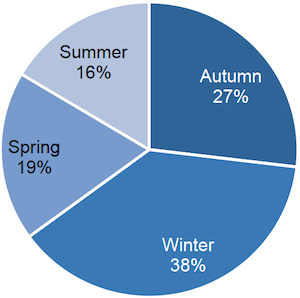
Rodenticide bait type and target
Baits formulated with grain were the most commonly encountered in this survey, accounting for 90 per cent of use by weight (Figure 8). These baits were primarily loose grain and place packs containing grain, but also included a small amount of grain based paste (two per cent of total grain baits).
The other types of rodenticide products encountered included wax based baits, which accounted for seven per cent of use. Ninety per cent of wax baits were solid wax baits and 10 per cent were soft waxes. Pasta based bait contributed three per cent of total use, gel rodenticides and other paste baits (for which the type of bait was not specified) were both estimated to account for less than one per cent.
Grain baits also accounted for the majority of rodenticides used in the previous two arable surveys in 2014 (93 per cent) and 2016 (86 per cent).
Survey respondents were asked to state the target of their rodenticide baiting regimes (Figure 9) and this information was supplied by over 99 per cent of estimated use by weight. Where reason data were supplied the most common target was a combination of rats and mice (52 per cent), followed by rats (46 per cent). Only two per cent of rodenticide use was targeted at mice alone. In the previous two surveys the principal target was also rats (60 and 58 per cent in 2014 and 2016 respectively).
Figure 8 Type of rodenticide bait used on arable farms (percentage of total weight) - 2018
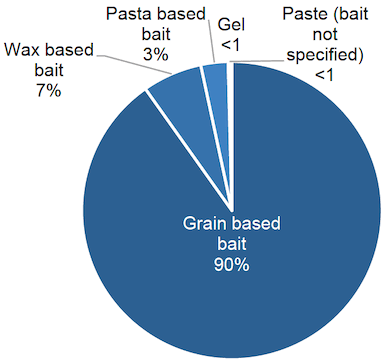
Figure 9 Target of rodenticide use on arable farms (percentage of total weight) - 2018
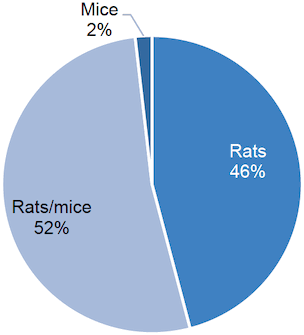
Contact
Email: psu@sasa.gov.scot
There is a problem
Thanks for your feedback